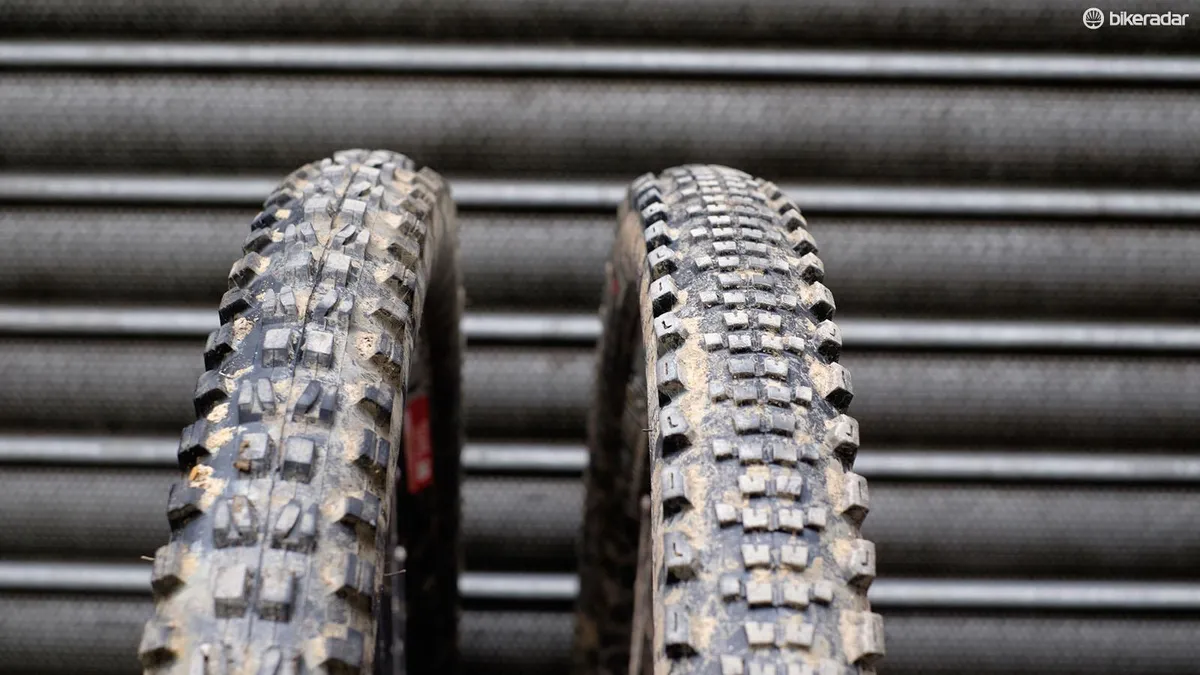Unless you’ve been living under a rock for the past year or so, you’ll probably have heard a lot of speculation about plus-size tyres. Everything from far-fetched marketing nonsense to vitriolic condemnation has been plastered all over the internet: often in all capital letters, so you know it must be true.
At BikeRadar, we like to find out for ourselves what really works and what doesn’t, so we set out to try and answer a simple sounding question: could plus-tyres ever be faster than normal ones?
Since 27+ wheels have a similar outer diameter to 29ers, it’s possible to install 29in wheels in a 27+ bike (or in some cases, vice-versa). As if to underline the point, Scott’s Rémy Absalon used a pair of 29in wheels in a plus bike to win the 2015 Megavalanche.
This gave us an idea. Why not use a 27+ bike to compare both 27+ and 29in hoops? That way, everything other than the wheels can be kept the same. By comparing times over seven different tracks, totalling no less than 56 timed runs, we’ve learned a lot about those funny-looking tyres. It's fair to say it was an eye-opening test – read on for all the details, and check out the video below.
27.5+ vs 29er – which is faster?
The bike
A Specialized Stumpjumper FSR Comp 6Fattie was the test subject of this experiment. With 150mm/135mm travel and based on the original Stumpy 29er, it represents a fairly typical trail bike, just with fat-tyre compatibility.
Geometry wise, the 437mm chainstay, 51mm fork offset, and 67-degree head angle would not look out of place on a 29er.
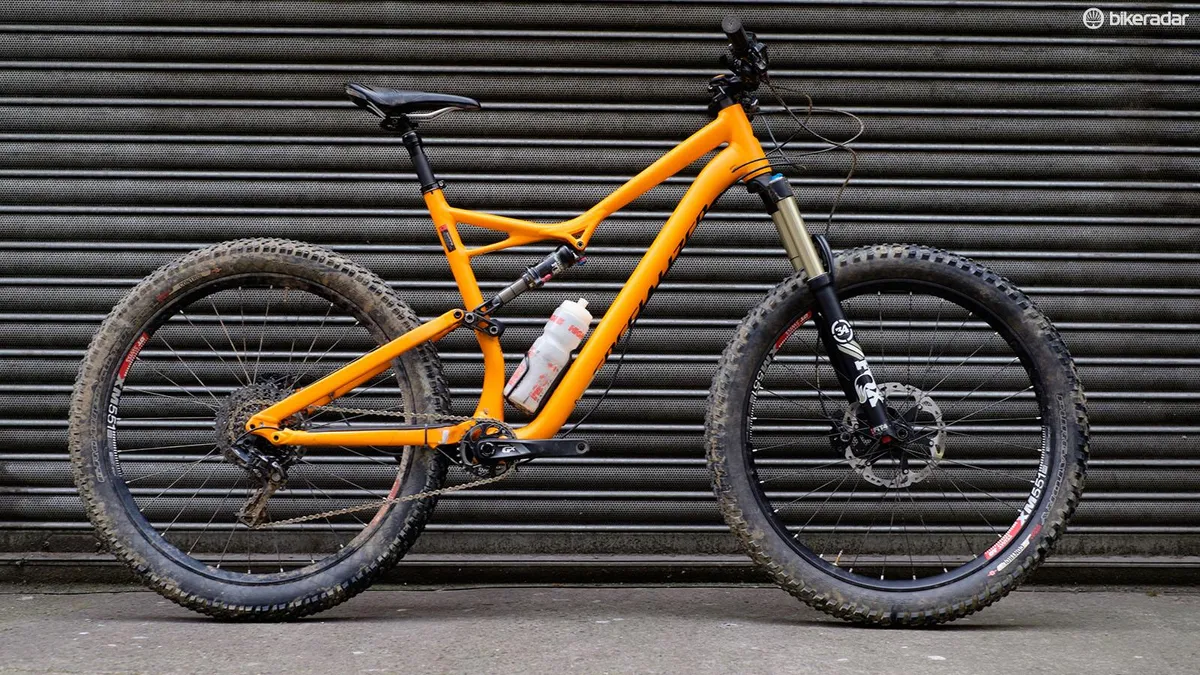
Our Specialized Stumpy 6Fattie test rig, fitted with 3in tyres on 40mm DT Swiss rims
One inevitable difference in geometry between the two wheel sizes was the BB height. With 27.5 x 3in tyres, the BB is super-low at 329mm, but swapping to 29x2.3in rubber raised it to 333mm: a small difference, but the Stumpy’s low BB means it was far from high even with the 29er wheels.
The wheels
In order to keep things fair I got hold of the most comparable wheels possible. Both spin on DT Swiss 350 hubs and the spokes and nipples are identical too. We went for DT’s 40mm wide XM 551 rim for the plus-tyres, and the 30mm wide XM 481 for the 29er option. We then fitted identical rotors and cassettes on each wheelset.
We stuck with Specialized’s 3.0in Purgatory / Ground Control tyres for the plus option, and tried out three combinations of ‘normal tyres’ to compare against. These were the 2.3in version of Specialized’s Purgatory Control / Ground control to give the most direct comparison to the big rubber; a Specialized Butcher / Slaughter Grid combination for more comparable weight and grip levels, and a Maxxis Minion DHF for the ultimate race-proven tyre.

Specialized's 3in Purgatory / Ground Control tyres (left) were used throughout our experiment
Tyre pressure was critical to getting the most out of each tyre and making the comparison fair. To keep it consistent, I hit a section of hardpack berms as hard as I could on each tyre, and lowered the pressures until I could start to feel the tyres squirming. This defined the pressure used throughout testing. The pressures are shown in the following table:
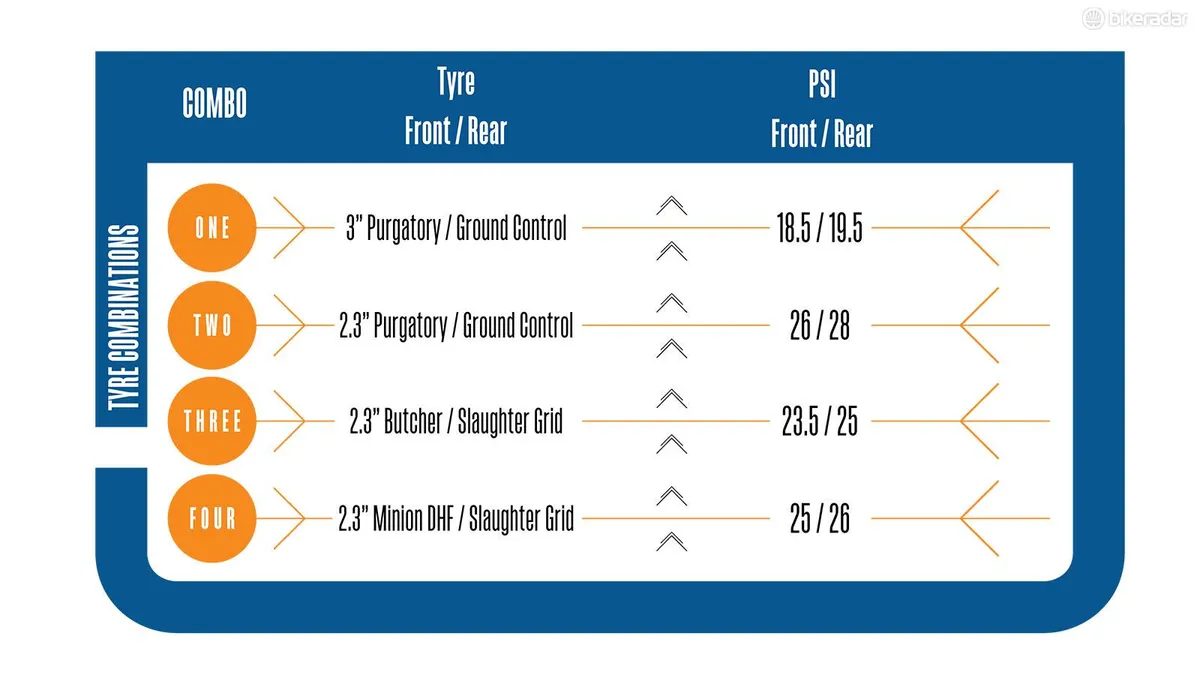
The weight problem
The unfurnished wheels weighed 1937g for the 27+ and 1864g for the 29ers. The 3in tyres weighed 1045g and 985g, whereas their 29x2.3in equivalents weighed 766g and 760g. Overall then, the plus setup worked out 577g heavier.
That sounds like a lot, but I subsequently found that much beefier conventional tyres were needed to deliver similar grip and low-pressure characteristics to the plus tyres. We spent a lot of time testing a Butcher/Slaughter Grid combination, weighing 960g each. That meant the total weight difference was reduced to 183g.
Getting the measure of the 6Fattie Stumpy
Before getting the stopwatch out, I wanted to get familiar with the Stumpy: experimenting with tyre pressures, suspension settings and adjusting my riding style to the big rubber. I headed to some steep and technical Welsh trails – trails that I've become very familiar with.
I soon discovered that I required at least 18psi in the front and 19psi in the rear to prevent the tyres from rolling and squirming on the 40mm rims. I’m very particular about my rebound settings, and found that the extra bounce from the big tyres was bucking me on fly-offs, so I set the rebound one click slower than I would normally run to address this.

Our test rig fitted out with 29in wheels and 2.3in tyres
The Stumpy’s rear suspension is not nearly progressive enough, so I added Fox’s largest volume spacer to the shock to get it close to balancing the Fox 34 fork, which is not overly progressive itself. I left the shock in the medium compression mode throughout, and experimented with doing the same to the fork to add support on the descents. This worked fine with the plus tyres, but gave an intolerably rough ride with 2.3in rubber, so I ended up leaving the fork open for both wheelsets to keep things fair.
At first, the front tyre was prone to floating and surfing over muddy ground, but this could be remedied somewhat by weighting the front wheel extra hard and leaning the edges of the bike into corners exaggeratedly.
Once my technique and bike setup were tuned in to the demands of the big tyres, I was impressed with the extra confidence, stability and traction they offered. Riding with several properly quick riding buddies, I noticed I was riding rooty corners clipped in when they were dabbing; I seemed to carry more speed through rough, flat straights; and felt faster and more planted on rocky lines. This could all be subjective though, so it was time to break out the timer!
The experiment
The first thing I was keen to establish was whether the bigger tyres rolled significantly more slowly. This meant doing a roll-down test. I marked out a section of slightly downhill fire road, with a third marker point 10m further up the hill. Starting at the highest marker at a standstill, I clipped in, steadied myself and rolled down to the second marker without pedalling, where I started the timer. This allowed me to get my balance before the timer was started, reducing the effect of little wobbles when setting off.
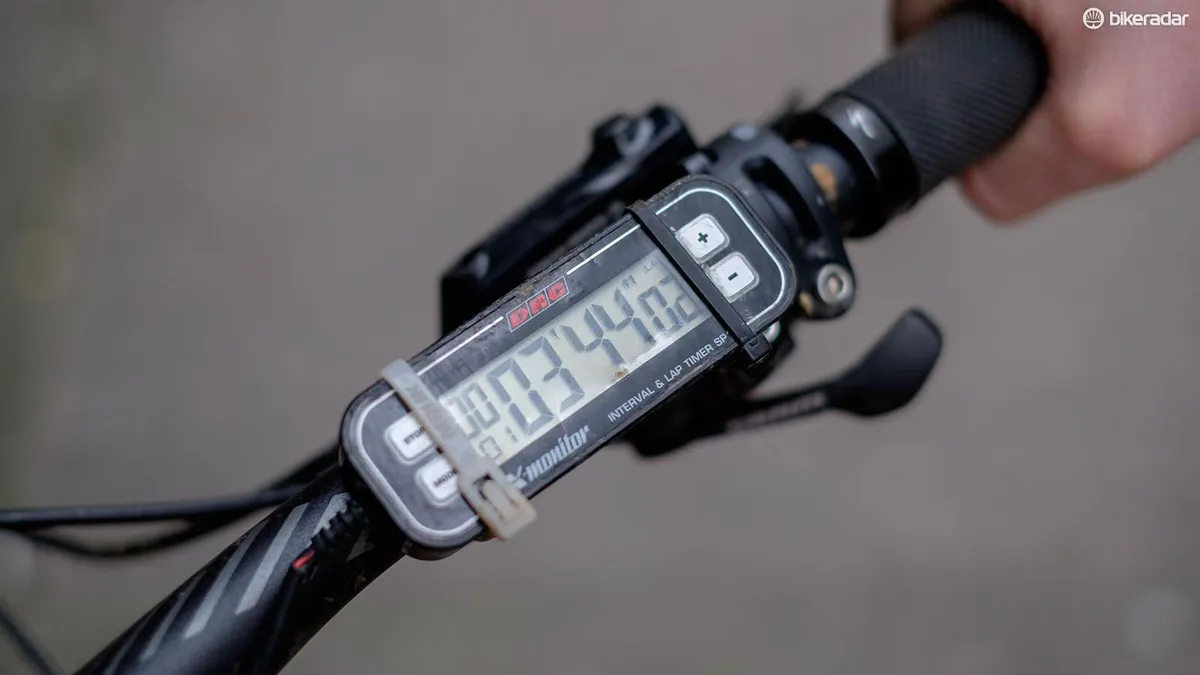
We timed each run using a simple DRC moto timer
Keeping my body position fixed so it could be easily repeated on each run, I rolled down to the third marker where I stopped the clock. This was repeated on each wheelset five times. Throughout the experiment, I always made sure that the brakes weren’t rubbing at all after swapping wheels.
The table below shows the time (in seconds) taken for each tyre to complete the same distance. The pressures used here were the same as those used on the trail, and are shown in the table.

Surprisingly, the plus tyres were faster rolling than the 2.3in equivalents on this particular fire road, which was quite bumpy and slightly muddy in places. It seems the fatter tyres held more speed through the bumps and soft ground than the 29in ones.
To check this, I repeated the test on a smooth tarmac road. Here, the plus tyres were consistently slower rolling than their 2.3in counterparts. I repeated the tarmac test on the Specialized Butcher / Slaughter Grid combination - these rolled more slowly than the plus tyres in this test.
Rolling resistance: the bottom line
So, on tarmac the plus tyres had more rolling resistance than their 29in counterparts, but less than the Butcher/Slaughter Grid tyres. While on our bumpy fire road, the plus tyres rolled faster than even their 29in counterparts.
The rolling resistance of the plus tyres is not necessarily higher than conventional widths; it depends on which tyres you compare them to and what terrain you test them over – big tyres appear to roll faster over soft or bumpy ground.
Technical riding
To see if plus tyres work in the real world, I set out to simulate typical trail/enduro riding with five very different stages, all mostly downhill. For each trail, I completed two or three scoping runs to get familiar with it. Then I did up to three timed runs per wheelset, swapping wheels between each run to cancel out the effects of fatigue, or familiarisation with the trail. I started in the same gear each time, and tried to hit the same line every run to keep things as controlled as possible. I went as fast as I could without the risk of making a mistake becoming too high – a similar pace to racing enduro.
Trail one: the rooty traverse
The first 'stage' was just under two minutes of fiddly roots, slightly muddy ground, a few ruts and nasty off-camber corners with a small climb thrown in too. The plus tyres were pitted against their 2.3” counterparts – the Purgatory/Ground Control tyres - for this stage. The times are shown below.
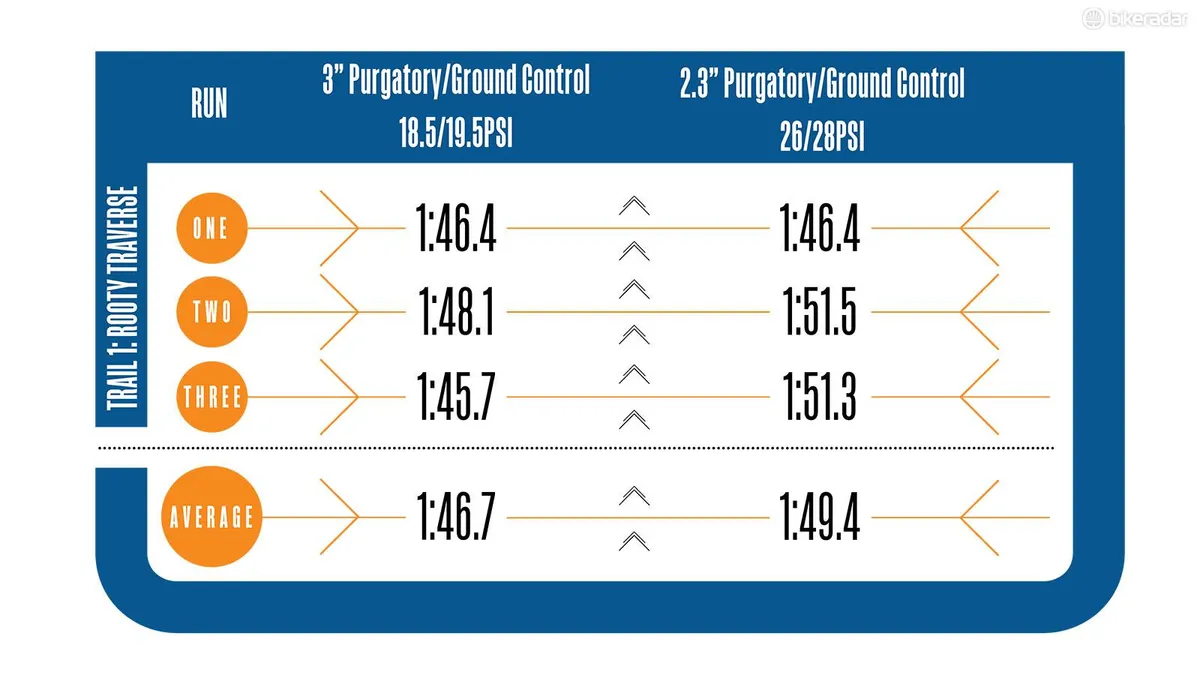
Here, the plus tyres were generally faster, although there was a little overlap between the times for each wheelset. Still, on average the plus tyres were 2.7s faster, which works out as 1.5s/minute. The bigger tyres were far more planted and less fiddly to handle over the random rooty ground, and appeared to slow down less over the bumps. Despite the extra heft, they carried far more speed here.
Trail two: the trail centre descent
This stage was made up of the final descent of the Blue-graded Verderers trail in the Forest of Dean at the English/Welsh borders. Composed of a slightly pitted and cobbly trail surface, it features many pump-bumps and bermed corners, as well as a few flat and slightly loose ones. Rather than repeating it several times, I split the trail into three sections that avoided the uphill sections. After a scoping run, I timed it on the plus tyres first, then the lighter 2.3in tyres, then the plus tyres again, before breaking out the gripper Butcher/Slaughter combo. The times are shown below.
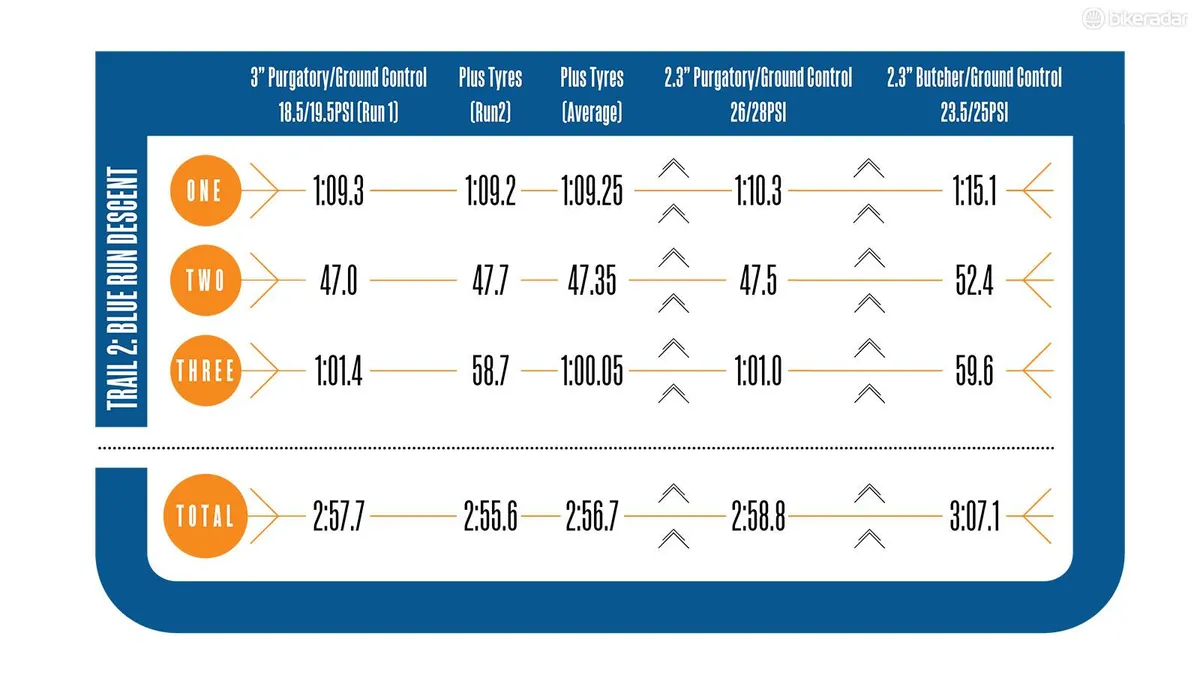
Here, the plus tyre runs were remarkably similar in time, but were each slightly faster in total than the lighter 2.3in tyres. The slower rolling Butcher/ Slaughter pairing was significantly slower overall, but were faster on the steeper bottom section. The thick carcass seemed to lose far more speed over rough ground up top. On average, the plus tyres were 0.7s/minute faster than the Purgatory/Ground Control tyres and 3.3s/minute faster than the Butcher/Slaughter pairing.
Trail three: the muddy corner track
Next, I wanted to find out if the plus tyres could keep pace with the grippy Butcher/Slaughter tyres on a short, muddy corner track. A slippery sprint into a muddy bomb-hole was followed by a long, off camber turn, then three sets of rutted, muddy chicanes before a greasy chute onto a fire road, turning hard right with a quick sprint to the finish marker. This is the kind of trail I enjoy riding the most, so I was keen to see how the plus tyres would compare. The times are shown below.
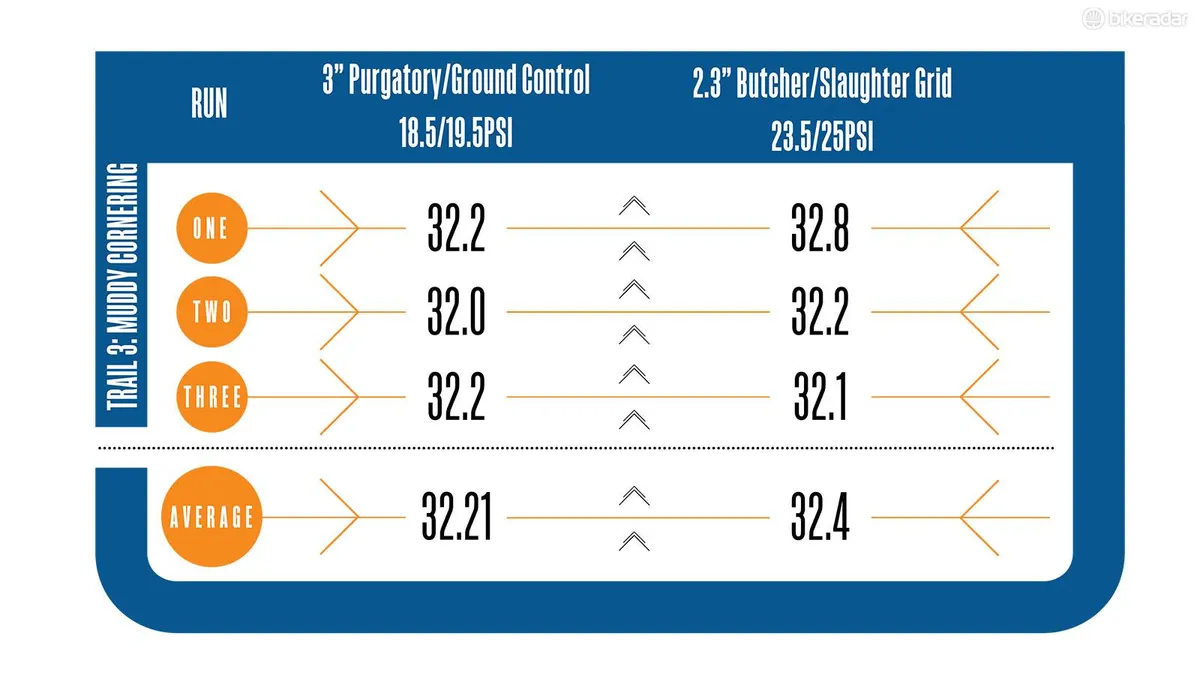
Here, the plus tyres went slightly faster on average – but there was only 0.17s in it. Given the range of times for each tyre being much more than that, it would be misleading to say they were ‘faster’ on this test, as the difference is statistically insignificant. Suffice to say that they were about the same, or more testing would be required to find out if one was in fact faster than the other with any certainty.
Trail four: the rooty DH track
Perhaps the most 'complete' trail of the lot, trail four incorporates one of the Forest of Dean’s most-loved DH tracks, 'Sheepskull'. It begins with a section of tight muddy turns, before opening up into a faster section, which leads into a mat of speed-sapping roots. Dropping over the fire-road introduces some drops, off-camber chatter and rocks, before some hard-pack berms and a sprint to the finish. The times for this trail are below.

The plus tyres were on average 4.8 seconds faster over the course, which works out at about 2.1s/minute. That performance edge was consistent too, with the quickest time on the 29in wheels being over 2secs slower than the slowest time on the plus tyres. They seemed to carry much more speed over the rooty sections, and could hold a line with much more stability in the rough or off-camber lines.
Trail five: the rocky black run
I then headed to BikePark Wales to ride a long, rocky and physical black-grade descent, dubbed '50 shades of black'. Full of loose rock, roots and rock-gardens, as well as jumps and muddy corners, it’s a track I often use to test suspension. I decided to switch tyres for this: swapping the Specialized Butcher for a Maxxis Minion DHF, in the sticky 3C Maxx Terra compound and 850g Exo casing. For the 29in tyres, I used 25Psi in the front and 26psi in the rear, with 19/20 Psi in the plus tyres.
As it was a longer descent, full of hidden lines and hidden potential, I decided to do three untimed scoping runs to get the feel for the course. This only left time for two timed runs on each wheelset. Also, I had no time to alternate wheels between each run; I did two runs on the 29in tyres, followed by two runs on the plus wheels.
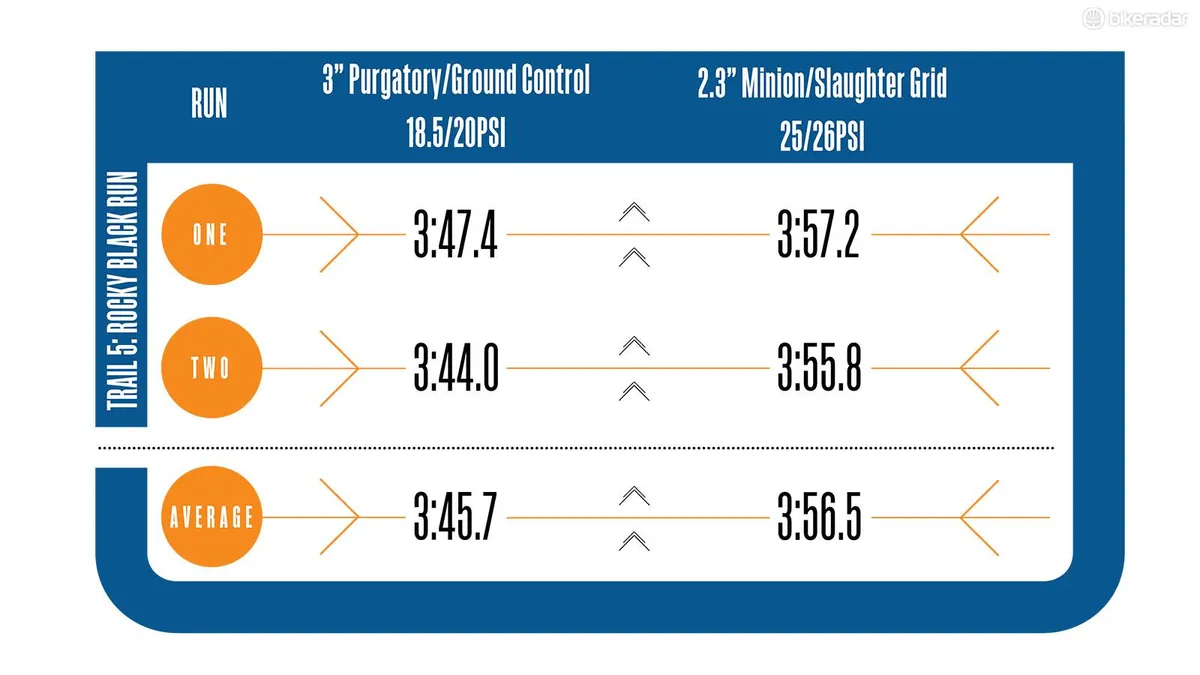
On average the plus tyres were 10.8 seconds faster over the whole course, or 2.7 s/minute. Of course, some of this difference may be down to the fact that the plus tyres were tested second, and I may have been more familiar with the trail as a result. This is unlikely to account for the whole of the 10.8s difference between each wheelset, however.
It felt as if the plus tyres carried far more speed over the flatter rocky sections. Interestingly, they didn’t seem to result in less hand pain at the end of each run, though.
Conclusion
While this is by no means an exhaustive scientific test, the timed runs performed here suggest that plus tyres can, in some conditions at least, be faster than conventional width rubber.
I only tested one set of plus tyres, and only compared them to three different combinations of 29in tyres. Aside from the Purgatory/ground control combination (which was chosen to keep the comparison as direct as possible), the 29in tyres chosen are all well-reviewed, race proven and some of my favourites.
Tyre pressures are critical in any tyre. While we didn’t experiment with different tyre pressures against the clock, pressures were selected to optimise performance for each tyre. We chose the minimum pressure required to prevent tyre-squirm in hardpack corners. This resulted in 18-20psi in the plus tyres, where traction was still markedly better than the conventional widths over rough ground. The advantages of plus tyres were not negated by going up to 20psi.
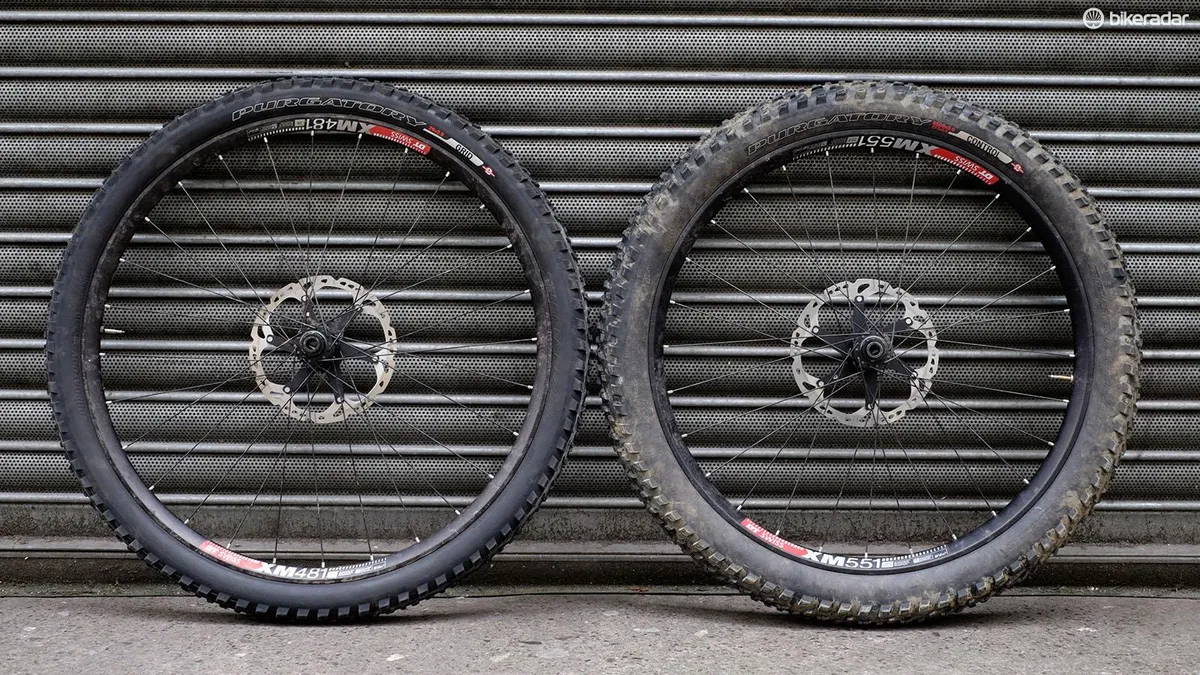
The 29x2.3in tyres were about 8mm larger in diameter than the 27.5x3in rubber, resulting in a 4mm higher bottom bracket
We can only speak for one rider and one bike. The Stumpy we used was much shorter in the reach than I’m used to, and really needed a 60mm stem to feel comfortable. This made the bike feel twitchy and nervous when pushing hard over gnarly terrain, especially with the narrower rubber.
The extra width and smoothness of the bigger tyres; the slightly lower BB height of the 27+ wheels; as well as the additional gyroscopic stability generated by their extra mass, made the bike more stable at speed with the bigger rubber. If the bike had more inherent stability due to a longer wheelbase, slacker head angle and shorter fork offset, the difference in times over gnarly terrain may have been reduced. I’m keen to repeat the experiment with a bike whose geometry is more to my tastes, such as the Pole Evolink 140. Watch out for that.
All in all, the plus tyres seem to deliver a better balance of rolling resistance and traction than conventional tyres. Our rolling resistance tests suggested that drag is not too bad on tarmac, and may actually be reduced on certain rough or soft surfaces. This was borne-out on the trail, when the big rubber seemed to slow down much less on rocky and rooty sections. Think of it as the improved rollover benefits of 29ers over 650b, only more so.
The other side of this equation is the improved traction. As evidenced by our muddy corner track, the grip is not necessarily better in mud (although remember that I was comparing the plus tyres to some considerably draggier rubber). However, the low-pressure compliance and large contact patch means the tread is pressed into the ground far more consistently over rough ground – this is known as mechanical grip. This results in far more predictable traction over rooty and rocky terrain. When we talked to Michelin’s pro athletes such as Nico Vouilloz, this predictability was high on their list of requirements from a tyre.
Punctures? Not even one. Even after over 10,000 rocky and rooty vertical metres. Two sets of Shimano brake pads are utterly spent and a SRAM chain was snapped too many times to be salvaged, but not a single flat (to be fair, that includes the 29ers). Bear in mind that I was using at least 18psi for the most part, along with a generous 150ml of sealant per tyre.
But are plus tyres still fun? Yes. Going fast on a mountain bike will always be fun. Some may not like the feeling of being more disconnected from the trail, especially at lower pressures, but we had a blast.
The future
The 1000g tyres I was running felt like they could do with more sidewall-reinforcement for cornering stability. Many top enduro racers are running 1200g DH tyres as it is, and aggressive riders using plus tyres could use another 200g at least. Chunkier plus tyres are in the pipeline, though.
So, should you go out and replace your current bike with a brand-new plus-sized model? Well, that’s your call. Another option might be to experiment with plus tyres in a conventional 29er, if you have the clearance. Alternatively, just enjoy riding your bicycle, and remember that significant timing gains can be made by simply setting your bike up correctly. As ever, don’t believe all the marketing hype, but when put against the clock on certain types of trail, the advantages of plus tyres are real and measurable. It all adds up.
Tested: Racing enduro on plus tyres
BikeRadar technical editor Tom Marvin picked out four very different 650b+ bikes and set himself the mission of finding out where the new standard excels, and where it doesn't…

